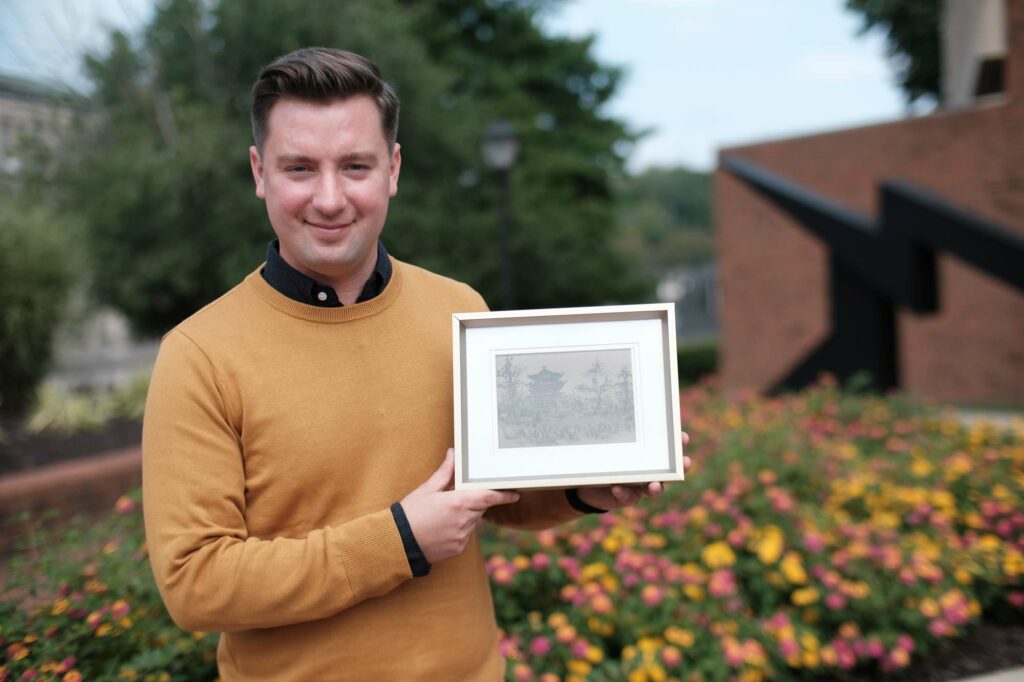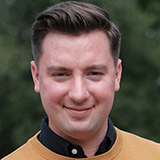Fun Fact
Hupe’s position was previously held by Diane Ahl, Arthur J. ’55 and Barbara S. Rothkopf Professor Emerita of Art History. Both graduated from UVA and had the same adviser, Ahl being one of the adviser’s first students and Hupe being his last.
What I’m teaching
Introduction to Art History II, Italian Renaissance Art
What I’m focused on
I study the representation of light in 15th-century Venetian paintings. There is a luminous quality in the paintings from that time where light becomes a protagonist in the works, a quality not seen again until the Baroque period. My scholarship centers around the intersection of art, optics, and theology to see how artists understood the light of their paintings and unravel its deeper spiritual meaning. My work focuses on a group of Franciscan friars at Oxford, England, who in the 12th century translated Islamic optical texts into Latin. Those translations were used by Franciscan theologians to develop a whole metaphysics of light that frames Franciscan theology. Optics in the Early Modern period was not limited to understanding the properties of light, but also was tied to a deeper understanding of the eye and vision. Franciscans went on to be the greatest patrons of art in the Early Renaissance, and it seems that their value of sight inspired their patronage. At that time, natural philosophers and theologians believed the eye worked by emitting rays that would be met by the rays emitted by perceived objects. This belief elevates the importance of visual perception where the viewer plays an active role in sight by either accepting or rejecting the divinely created world. Therefore, by looking and observing the world around us we were thought to gain a better understanding of God. Art, then, that represented the world accurately (the rise of naturalism defines Renaissance art) was thought to help believers know and communicate with the divine. All of this, of course, was possible because of the light that allows us to see.
What drew me to Lafayette
I grew up in the Hudson Valley region of New York, so I am happy to be closer to family. Despite that proximity, I didn’t know about the College until a lifelong best friend had two siblings attend Lafayette. For years both of them and their parents spoke so highly about the college; I always found that striking. I place teaching at the forefront of my work, which made a liberal arts institution the top place for me when looking for a home. I am passionate about interacting across disciplines, small class sizes, and study abroad opportunities for instruction, all of which define Lafayette.
What students can expect
I am a big proponent of immersive learning. Nothing compares to seeing a work in the site it was meant for. It is difficult to relay that experience while looking at slides in a classroom. So I incorporate virtual reality (VR) into my classes. We have VR day once a week where we focus on a single work of art. That VR tour is what I call a close-study day—an opportunity to slow down and focus on the quality of looking rather than the quantity. I received a Teaching with Technology grant at the College and am developing and doing a comparative study of several VR platforms where we can go even deeper and truly travel the world through a headset. It is the closest equivalent to traveling to the locations I have found. I also am excited about the possibilities this technology holds for making learning more democratic. No longer will students be hindered for not having the resources to travel the world—a luxury I did not have growing up.
 What I’m holding
What I’m holding
This is a painting my mother made. She died several years ago, and when we had to decide what to keep from her belongings, I was sure to take this. My mother loved art, and as a child I loved to look at her portfolio from art school. Rather than keep a picture of her on my desk, I have this, which has more value and more intimacy. In some respects the painting is more a drawing, and I love the frenetic quality of the line. It’s as if I can see her mind at work with each stroke. Drawing as a medium has an immediacy that illustrates the mind-to-hand connection of the artist. I really see my mom in it more than I would in a photo of her. It evokes her and connects me to the past, a similar connection I feel when looking at works created hundreds of years ago … and to today as chapters of my dissertation pad the back to help sturdy the frame.
What’s not on my CV
I love food! Cooking food and making art are both creative outlets. I grew up in a family of painters and cooks. So I love to cook, host dinner parties, eat, and travel to eat. I cook a variety of cuisines; most recently I am exploring Korean food. My grandmother was Korean and German, so cooking helps me maintain a connection to her. So when I’m not at my desk, I’m probably at my stove.

 What I’m holding
What I’m holding